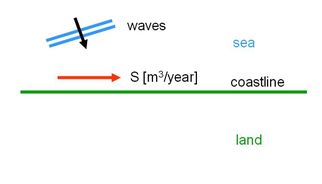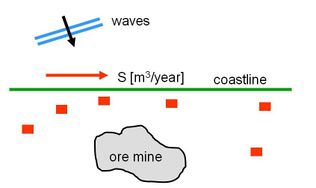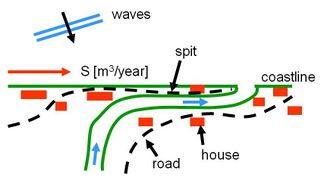Difference between revisions of "Sand by-pass systems"
(→Introduction) |
(→Solution with sand bypass system) |
||
| Line 34: | Line 34: | ||
<p> | <p> | ||
== Solution with sand bypass system == | == Solution with sand bypass system == | ||
| + | Fig. 5 shows that a large port with two long breakwaters has been built indeed along the sandy coast. | ||
| + | In Fig. 6 the position of the mouth of the river has been stabilized with the help of two jetties. In selecting the position where the jetties are built, the cyclic process of the shifting position of the mouth of the river should be taken into account. A position in the beginning of the cyclic process is recommended. | ||
| + | <p> | ||
| + | In both cases of Figs. 5 and 6 the long breakwaters/jetties interrupt the sediment transport along the sandy coast. The classical processes of accretion of sediment at the up drift side of the structures and the erosion at the down drift side will start right after the construction. Fig. 7 shows schematically what happens in case of a single jetty which interrupts the sediment transport. At the seaward end of the long jetty no sediment will pass the jetty (for the time being); accumulation of sand will occur at the up drift side. At some distance from the jetty at the down drift side the sediment transport along the coast is again the same as the original sediment transport at the up drift side (Sout = Sin). The down drift part of the coast does not receive sediment (S = 0) along the jetty, while Sout leaves that part. Structural erosion will occur. | ||
| + | <p> | ||
| + | <br> | ||
| + | <p> | ||
| + | ===Accretion=== | ||
| + | <p> | ||
| + | In some cases the accretion at the up drift side is not felt as a problem for the coastal zone manager; valuable ‘new’ land is created. (However, sooner or later the accretion of the coast reaches the seaward end of the jetty. Sediment will pass the structure. One of the main functions of the structures, stopping the sediment transport, is then not fulfilled anymore.) | ||
| + | <p> | ||
| + | <br> | ||
| + | <p> | ||
| + | ===Erosion=== | ||
| + | <p> | ||
| + | The consequences of the process of erosion at the down drift side are almost always a big problem. Ultimately mainland is lost. When the port like in Fig. 5 was built in a really inhospitable remote area, the erosion of ‘worthless’ land might be acceptable at a first glance. However, even a port mainly meant for the export of ore will attract a lot of other economic development. Rather soon the whole area will be booming; the ‘worthless’ land will become valuable. | ||
| + | So, the structural erosion at the down drift side is a problem which has to be resolved by the responsible coastal zone manager involved. | ||
| + | Often the erosion problem is seen as a separate problem; elsewhere along the coast also eroding stretches are observed. With ‘hard’ measures, e.g. groynes, shore parallel detached breakwaters, and even seawalls and revetments, the erosion is tackled. (Seawalls and revetments are by the way a very bad solution for this type of erosion.) In stead of ‘hard’ measures, and often far better, ‘soft’ measures like artificial nourishments will be used. | ||
| + | <p> | ||
| + | The rate of the sediment transport along the coast determines for a great part how serious the accretion and erosion problems are in the vicinity of the structures. Whether the sediment transport is e.g. 100,000 m3/year or 500,000 m3/year makes a great deal of difference. | ||
| + | <p> | ||
| + | <br> | ||
| + | <p> | ||
| + | ===Sand bypassing=== | ||
| + | <p> | ||
| + | The most straightforward solution for the erosion problem (and the accretion problem) is to artificially restore the sediment transport along the structures as meant in the Figs. 5 and 6; applying a sand bypass system. | ||
| + | Fig. 8 schematically shows this idea. The idea of artificial sand bypassing is so straightforward and seems so self-evident that it is remarkable that in practice this idea is applied in only a relatively small number of cases. | ||
| + | It is a good thing that nowadays coastal zone managers and coastal engineers have an open mind with respect to the (often: adverse) consequences of building breakwaters and jetties to the morphological system. Sand bypass systems are a good tool now. | ||
Revision as of 14:38, 30 August 2012
Contents
Introduction
Figs. 1 and 2 show two examples of pure natural stretches of sandy coasts. Fig. 1 reflects just a sandy coast with a net alongshore sediment transport.
Fig. 2 deals with a situation where a modest river flows out into the sea. Along the coast a net sediment transport is present in the right direction. In Fig. 2 two situations have been sketched; the present situation and the situation after a couple of years. Due to the river discharge and the net sediment transport at sea, the position of the mouth of the river shifts in the right direction with time. A long spit is formed between the sea and the left bank of the river. The river flows for some distance more or less parallel to the coastline. This process of shifting of the mouth of the river will not continue for ever. When the river becomes longer and longer the water level, say in point P in the river becomes higher and higher. At a certain moment the spit will break (at point P in the discussion) and a new mouth is formed farther upstream; the old mouth will close. The shift of the mouth resumes again; it is cyclic process with time.

|

|
| Fig. 1: Natural situation | Fig. 2: Natural situation; free development |

|

|
| Fig. 3 Ore found | Fig. 4 Situation with roads and houses/hotels |
The coastal processes as meant in Figs.1 and 2 occurred without human involvements for thousands of years.
Figs. 3 and 4 show the same cases as Figs. 1 and 2, but now with human interests. These human interests have become more and more relevant during say the last hundred years only. In the example of Fig. 3 ore has been found close to the coast; export of ore is a big opportunity for the economy; a large sea-port is required. Fig. 4 shows a situation where infrastructure like roads and buildings has been built in the coastal area. Often the river mouth is also used for navigation. The ever changing position of the mouth of the river is a serious draw-back in this area. One often likes to stabilize the position of the river mouth.
In stead of a port and a river mouth, used in this contribution as examples, also a tidal inlet of a lagoon could be chosen; similar considerations as given so far hold in that case.
Solution with sand bypass system
Fig. 5 shows that a large port with two long breakwaters has been built indeed along the sandy coast. In Fig. 6 the position of the mouth of the river has been stabilized with the help of two jetties. In selecting the position where the jetties are built, the cyclic process of the shifting position of the mouth of the river should be taken into account. A position in the beginning of the cyclic process is recommended.
In both cases of Figs. 5 and 6 the long breakwaters/jetties interrupt the sediment transport along the sandy coast. The classical processes of accretion of sediment at the up drift side of the structures and the erosion at the down drift side will start right after the construction. Fig. 7 shows schematically what happens in case of a single jetty which interrupts the sediment transport. At the seaward end of the long jetty no sediment will pass the jetty (for the time being); accumulation of sand will occur at the up drift side. At some distance from the jetty at the down drift side the sediment transport along the coast is again the same as the original sediment transport at the up drift side (Sout = Sin). The down drift part of the coast does not receive sediment (S = 0) along the jetty, while Sout leaves that part. Structural erosion will occur.
Accretion
In some cases the accretion at the up drift side is not felt as a problem for the coastal zone manager; valuable ‘new’ land is created. (However, sooner or later the accretion of the coast reaches the seaward end of the jetty. Sediment will pass the structure. One of the main functions of the structures, stopping the sediment transport, is then not fulfilled anymore.)
Erosion
The consequences of the process of erosion at the down drift side are almost always a big problem. Ultimately mainland is lost. When the port like in Fig. 5 was built in a really inhospitable remote area, the erosion of ‘worthless’ land might be acceptable at a first glance. However, even a port mainly meant for the export of ore will attract a lot of other economic development. Rather soon the whole area will be booming; the ‘worthless’ land will become valuable. So, the structural erosion at the down drift side is a problem which has to be resolved by the responsible coastal zone manager involved. Often the erosion problem is seen as a separate problem; elsewhere along the coast also eroding stretches are observed. With ‘hard’ measures, e.g. groynes, shore parallel detached breakwaters, and even seawalls and revetments, the erosion is tackled. (Seawalls and revetments are by the way a very bad solution for this type of erosion.) In stead of ‘hard’ measures, and often far better, ‘soft’ measures like artificial nourishments will be used.
The rate of the sediment transport along the coast determines for a great part how serious the accretion and erosion problems are in the vicinity of the structures. Whether the sediment transport is e.g. 100,000 m3/year or 500,000 m3/year makes a great deal of difference.
Sand bypassing
The most straightforward solution for the erosion problem (and the accretion problem) is to artificially restore the sediment transport along the structures as meant in the Figs. 5 and 6; applying a sand bypass system. Fig. 8 schematically shows this idea. The idea of artificial sand bypassing is so straightforward and seems so self-evident that it is remarkable that in practice this idea is applied in only a relatively small number of cases. It is a good thing that nowadays coastal zone managers and coastal engineers have an open mind with respect to the (often: adverse) consequences of building breakwaters and jetties to the morphological system. Sand bypass systems are a good tool now.